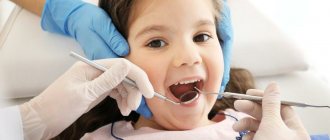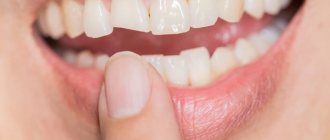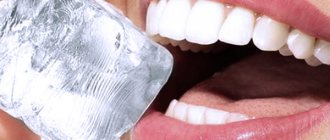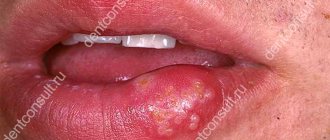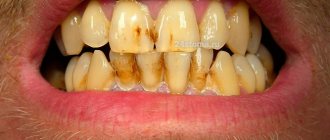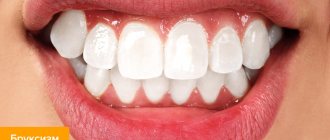The condition of the oral cavity and the skin around the mouth often reflects the internal state of the body. If a blue spot appears on the lip, this indicates the presence of certain malfunctions in the functioning of internal organs and systems. Also, blue spots on the lips can be the result of certain external factors. To get rid of this problem, you need to find out why dark spots or dots appear on your lips.
Why might a blue spot appear on the lip?
In most situations, the appearance of a blue spot on the surface of the lips indicates excess production of the melanin pigment. Also, the appearance of spots or dots may be associated with mechanical damage. The most common causes of this symptom are the following:
- Thermal burn. It can appear when drinking too hot drinks or food. It is important to consider that in case of a burn, a spot may not appear immediately, but after a certain period of time. With the systematic consumption of hot drinks, the delicate skin is injured, as a result of which it becomes bluish or brown.
- The use of low-quality cosmetics or expired cosmetics also negatively affects the condition of the lips. In this case, such a sign indicates the development of an allergic reaction.
- Prolonged exposure to ultraviolet rays without the use of sunscreen can cause photoaging of the skin, resulting in blue or brown spots.
- Taking certain medications. If a dark or bluish spot appears, this may be a side symptom after taking Tetracycline, Amiodarone, hormonal drugs and antipsychotics.
- Mechanical damage. Injuries and bruises of various types in the mouth area can lead to bruises. This also includes the habit of biting your lips, chapping, and frostbite.
- Increased pigmentation. This phenomenon is rare and indicates an increase in melanin.
- If a spot appears on the surface of the lip, this may be a sign of various changes in hormonal levels.
Other causes of this symptom include:
- weakened immune system;
- liver diseases;
- pathologies in the adrenal glands;
- parasitic infestations;
- excess iron in the body;
- avitaminosis;
- the appearance of warts or papillomas;
- smoking.
It is important to consult a doctor in time, since such a symptom, although uncommon, may indicate the development of a malignant neoplasm.
The discussion of the results
During the study, doctors studied data from clinical observation and histological analysis of 41 patients with genital melanosis. In 22 patients, the formations had several colors; in 11 patients they were more than 1.5 cm.
Researchers considered the average age of onset of this condition to be one of the clinical signs of benign genital melanosis. Among the study participants, it was 41 years. Genital melanoma develops on average in the sixth decade of life.
The researchers concluded that it is necessary to avoid unnecessary surgical intervention for genital melanosis. Clinicians consider it necessary to excise and send for histological examination all formations that seem suspicious to them. In the case of genital melanosis, this approach is not necessary. Most of the lesions examined during the study with clinical atypia, such as multiple colors and larger than 1.5 cm in size, were found to be benign.
Excisional biopsy in the genital area not only causes discomfort for the patient. The operation can harm sexual health and disrupt urinary function. The cosmetic result of the operation may be unfavorable.
Researchers have found that in most cases of genital melanosis, it is sufficient to actively monitor patients. Only one of the 41 study participants had both genital melanosis and genital melanoma. In this patient, genital melanosis was discovered almost 11 years after the diagnosis of vulvar melanoma. The formation was excised, and according to the results of histological examination it was recognized as benign.
During 30.5 months of follow-up, none of the study participants developed genital melanoma due to genital melanosis. In 19 patients who came for examination, the formations stabilized, decreased or disappeared. One patient was diagnosed with recurrence of genital melanosis after excision of the lesion.
Based on these data, the researchers concluded that the risk of genital melanosis transforming into melanoma is so small that it is difficult to measure.
The incidence of genital melanosis in the population is unknown. According to studies [1, 2], this condition occurs in 0.011% of patients who come to see a dermatologist. The incidence of genital melanoma is 0.19 cases per 1 million men and 1.8 cases per 1 million women. [4]
The study found that 15% of the experiment participants had a history of melanoma. In only one out of five cases the tumor was found in the genital area. The average age of patients with melanoma was 39 years.
Scientists have confirmed an increased incidence of genital melanosis in patients with a history of melanoma. Such patients have a suprabasal distribution of melanocytes, as well as an increased number of melanocytes in the epidermis.
Genital melanosis with clinical signs of atypia is recognized as an indication for active monitoring of patients, including examination of the whole body with a dermatoscope. However, according to the study, genital melanosis cannot be considered a precursor to genital melanoma. Therefore, in most cases, in patients with genital melanosis, radical surgery with excision of formations is not indicated.
When to worry
If bluish spots or dots appear on the lips, it is necessary to establish the cause of this symptom. If the cause is trauma, biting or other negative factors, the problem usually goes away on its own within a few days.
If the symptoms do not go away, the spots increase in size, pain and other alarming signs appear, you should not ignore them. It's better to see a doctor.
Methods
The study involved 41 patients with genital melanosis. The criterion for participation was the presence of a mass larger than 1 cm or multiple associated lesions whose total size exceeded 1 cm.
The patients were divided into two groups according to the size of the formation. The first included participants with formations larger than 1.5 cm, the second included participants with formations less than 1.5 cm.
Biopsies were performed in 35 of the 41 patients. During the histological examination, pathologists assessed, among other things, the following data:
- The number of melanocytes per square millimeter of the epidermis.
- Presence of nuclear atypia.
- Location of melanocytes in the epidermis.
Five patients were biopsied multiple times. Samples with the highest number of melanocytes per square millimeter of epidermis were used for overall statistical analysis.
How to get rid of the problem
If, after diagnosis by a doctor, diseases of the internal organs are excluded, you can get rid of such symptoms much faster. To eliminate hyperpigmentation due to excessive exposure to ultraviolet rays, it is necessary to use lightening cosmetics. At the same time, multivitamin complexes are prescribed: Vitrum, Supradin, Complivit.
To get rid of bluish spots, various cosmetic procedures may be prescribed:
- mesotherapy – whitening compounds are injected under the skin;
- phototherapy – the pigment is destroyed when exposed to ultraviolet waves;
- ultrasonic peeling.
Before undergoing such procedures with a cosmetologist, you must first consult with a dermatologist.
In order to improve lip color and eliminate areas of darkening, you can use traditional methods:
- lemon juice - place a drop on the stain, wash it off after half an hour and apply warm coconut oil;
- beet juice - apply to the desired area before bed, do not rinse;
- cinnamon oil – helps improve blood microcirculation, helps speed up metabolic processes;
- peeling with olive oil and granulated sugar.
Before using any product, you must first consult with a dermatologist and undergo the necessary examinations.
Homeopathic medicines
The success of homeopathic treatment, first of all, lies in an individual approach to each patient. The homeopathic doctor prescribes a drug suitable for the constitutional type of the patient . In this case, the chosen remedy will affect the health of the body as a whole .
Depending on the type of stain on the lip and the patient’s psychotype, the following drugs may be prescribed:
- Arnica (Arnica montana). The drug promotes the resorption of compactions and is used to treat warts and venous nodules on the lips. The constitutional type of Arnica is full-blooded, good-natured people. Most often they are friendly, but during illness they become moody and irritable.
- Calcarea fluorica. Effectively fights vascular tumors, increases the tone of capillaries and blood vessels, and helps in case of helminthic infestation. Prescribed to patients with malocclusion and severe asymmetry of the bone skeleton.
- Silicea . The product effectively fights papillomas and helps eliminate hyperpigmentation on the lips. Psychotype - thin, sickly people who tend to get nervous over trifles. They often freeze and do not tolerate mental stress well.
- Phosphorus (Phosphorus). The drug is prescribed if the appearance of defects on the lips is caused by dysfunction of the liver and adrenal glands. The constitutional type of the drug is tall, stooped people with soft blond hair. The character is sensitive, touchy and vulnerable.
- Bellis perennis. The drug fights the manifestations of excessive pigmentation on the lips and has whitening properties. Most often prescribed to older people who complain of constant fatigue and memory problems.
The popularity of homeopathic treatment is primarily due to the proven effectiveness of the drugs . In addition, the absence of side effects that often occur when using traditional medications can be considered a big plus. Any drug is prescribed individually by a homeopathic doctor , therefore, when a blue dot appears on the lip, consultation with a specialist will be the first step towards a successful cure.
What groups of ingredients are used to lighten skin?
Representatives of these groups should be sought in the compositions of combination drugs.
- Tyrosinase inhibitors – azelaic acid, arbutin, flavonoids, resveratrol .
- Destruction and reduction of melanosomes: niacinamide, soy extracts .
- Inhibition of DOPA and dopaquinone synthesis: kojic acid.
- Exfoliation of the stratum corneum: AHAs and retinoids.
- Stimulation of the conversion of melanin to leukomelanin: vitamin C, E and glabridin.
Summary : to effectively lighten pigmentation and reduce the likelihood of side effects, it is more advisable to use combined preparations containing ingredients from different groups.
SUMMARY FROM D.S.:
This study shows that age spots on the genitals are, in the vast majority of cases, NOT DANGEROUS. However, researchers note a possible increased risk of developing skin melanoma (not just the genitals, but also other areas) in people with genital melanosis. This means that if you have similar pigment spots, they must be examined annually with a dermatoscope by an oncologist or dermatologist, just like ALL other pigmented skin formations.


